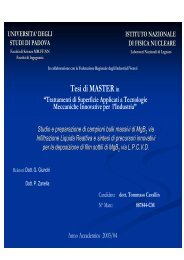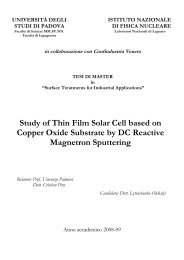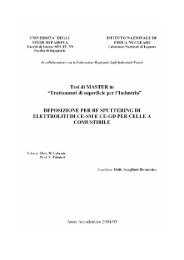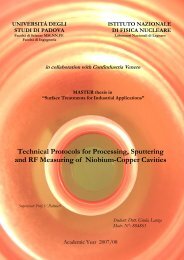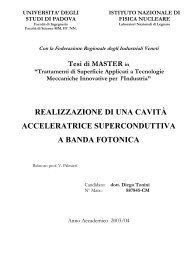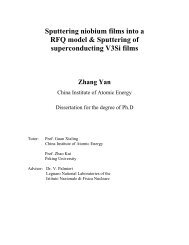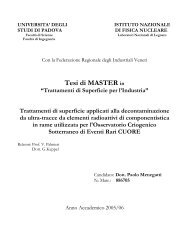Magnetron sputtering of Superconducting Multilayer Nb3Sn Thin Film
Magnetron sputtering of Superconducting Multilayer Nb3Sn Thin Film
Magnetron sputtering of Superconducting Multilayer Nb3Sn Thin Film
Create successful ePaper yourself
Turn your PDF publications into a flip-book with our unique Google optimized e-Paper software.
electron higher than 200GeV.The linear accelerators utilize a linear array <strong>of</strong> RF cavities and becomeincreasingly long, with lengths up to the tens <strong>of</strong> kilometer range, to achieve particleenergies in the GeV to TeV energy range that is <strong>of</strong> present High Energy Physics (HEP)interest. Such systems will require on the order <strong>of</strong> 20,000 RF cavities. Improving theaccelerating voltage per unit length will result in tremendous cost savings, since therequired length to achieve a given beam energy in a linear accelerator is inverselyproportional to the electric field that can be generated per unit length. In addition,power requirements are significant, ranging from 100 to 250 MW for a 500 GeVlinear accelerator.The main figures <strong>of</strong> merit for RF cavities are the quality factor Q 0 (defined by theratio between the energy stored in the cavity and the energy loss in one RF period)and its average accelerating field E acc . Q 0 values as high as 10 11 have been achieved insuperconducting cavities. <strong>Superconducting</strong> cavities exhibit approximately a factor 10 6higher Q 0 than normal conducting cavities due to the reduced microwave surfaceresistance. Even when accounting for cooling penalties the required input power isstill about a factor 10 3 lower when using superconducting cavities instead <strong>of</strong> normalconducting cavities, saving drastically in operating costs. The InternationalTechnology Recommendation Panel <strong>of</strong> the International Committee for FutureAccelerators therefore, amongst other considerations, selected superconducting RFcavities above normal conducting cavities as the preferred technology for future linearaccelerators [1] .1.2 The performance <strong>of</strong> the needed superconductor cavityThe efficiency <strong>of</strong> a RF cavity is usually depicted by plotting Q 0 as a function <strong>of</strong>E acc . For an ideal superconducting cavity, Q 0 remains constant with increasing E accand collapses when a maximum E acc is reached. This point is determined by themagnetic components <strong>of</strong> the RF standing wave. Once the magnetic componentreaches a certain threshold value, vortices penetrate the superconductor and theMeissner state is lost. Vortices that move inside the superconductor dissipate energyand cause the cavity to quench. Even though vortices can be elastically pinned bymaterial imperfections, their oscillations in an RF field will still cause dissipations [2] .Hence, vortex penetration has to be prevented to retain a high Q 0 and a cavity has tooperate in the Meissner state.4



